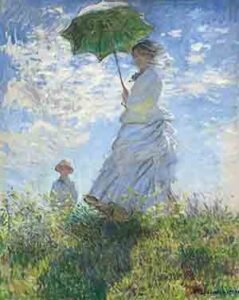This post is also available in: Español (Spanish)
Emergence
In the mid-nineteenth century, painters, attentive to social and scientific changes managed to connect with their environment in a different way. The paintings of academic study, were not natural in contrast to the external reality. Impressionism emerged in France in 1860. The impressionists painted abroad, immersed in nature, in order to capture the light in its constant changes, and grasp the immediacy and transience of the moments. This way of painting was called plein-air, in the open air, they finished their works in the place where they worked. Scenes from the daily life of Paris and the suburbs.
They were not openly accepted as Impressionists aware that they did not follow the guidelines given by the art academy. Its main representatives were Claude Monet and Aguste Renoir. The realistic style showed life in its crudest aspects. It was an art that showed social reality. Impressionism was not social, it was more to show personal experiences. We can consider its beginnings from its first exhibition in 1874 to 1886. However, we find outlines of impressionism from realism to post-impressionism.
New Techniques
The practice of outdoor painting, made the works were clear, without black shadows, the shadows are transparent and colored in nature. Objects and shapes vary according to the degree of luminosity. The objects and figures lose consistency in a constant change. They used juxtaposed brushstrokes of pure tones, the black is reduced to its minimum

expression. The contours are undefined, and the forms are expressed with short strokes and vivid colors. Each element was carried in its greatest simplicity.
To paint the lights and shadows the Venetian method was imposed, painted opaque lights and shadows and then added transparent glazes. Another feature was to load the surface uniformly. The clear bases were more persistent because they conserved their luminosity with the passage of time. This does not happen with dark shadows since they darken more with time.
Three factors influenced the development of this technique: the mechanical grinding of the colors, the binding oils and the additives used to keep the paint homogenous in the newly emerging tubes. The artists prepared the paint only when they needed it, but the expansion of the commercial colors in the nineteenth century gave rise to the need for them to retain their consistency before using them.
Impressionist painters take advantage of scientific advances, industrial technical advances, carrying out new research at the service of expressing through this the individual subjectivity. Achieving to capture a magic in the chromatic ranges, and the fugacidad of the chromatic elements of the luminance variations.
Chevreul chemist contributes his research on the simultaneous contrast of colors and harmony of colored objects, and the application of colors to the industrial arts over chromatic circles (1864). Chevreul divided the colors into primary (pure) and binary (formed by two colors), a binary color is enhanced next to the primary that is not part of its composition. He formulated the law of the simultaneous contrast of colors, demonstrating that the juxtaposition of colored objects modifies their optical nature, thus each color always tends to color itself of its complementary, and if both juxtaposed objects are colored by a common element, it gradually disappears.
Photography is for the Impressionists a help, it serves as a means to see better, an apprenticeship of sight, putting technique art service. The influence of Japanese art, which since mid-century is felt in Europe especially in Paris, we find in many artists attracted by the chromatic simplicity, the synthetic treatment of light and shadow. Informality in front of the laws of perspective, the absence of modeling of figures.
Evolution
They limited themselves to choosing those aspects of society and nature that suited their optimistic view of the world. Good part of its propagation a century later is due to the naturalness, to the hedonism with which they manifest the most pleasant aspects of a bourgeois little life with naturalness, surrounded by a maternal nature and a society whose problems do not express.
Its main representatives in Paris are: Monet, Pissarro, Sisley and Renoir. His predecessors are Jongkind and Boudin. Ind

ependent artists were Manet and Degas. Other artists who take new directions are Seurat and Signac, creators of pointillism or divisionism, Gauguin and Van Gogh tended to a symbolic expressivism, Toulouse Lautrec to Expressionism and Cezanne, ancestor of Cubism.

.png)